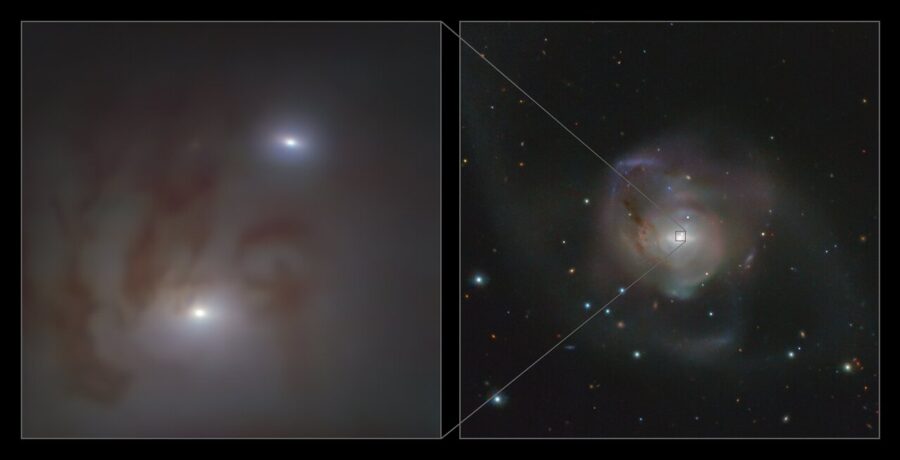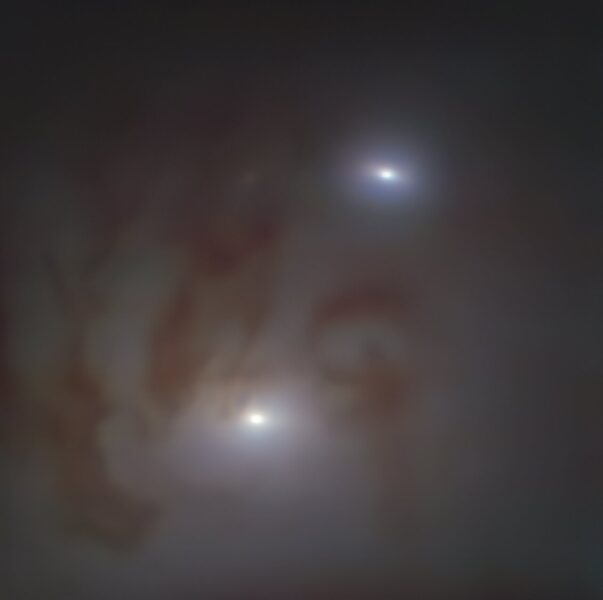Astronomers have observed a pair of supermassive black holes set to collide in 250 million years.
Astronomers have identified and weighed the nearest dual supermassive black hole, in a galaxy just 89 million light-years away. In the future, the pair will collide, releasing powerful gravitational waves.

ESO / Voggel et al.
Three years ago, a team led by François Schweizer (Carnegie Observatories) reported a compact, bluish concentration of stars just off of the bright center of NGC 7727, a somewhat distorted galaxy in the constellation Aquarius. This “second nucleus” turned out to produce faint X-rays, leading Schweizer and his colleagues to suggest that it might be the stripped core of a smaller galaxy with a mildly active central black hole that merged with NGC 7727 some 2 billion years ago.
Now, in Astronomy & Astrophysics, a largely European team of astronomers led by Karina Voggel (Strasbourg Observatory, France) presents evidence that both of the galaxy’s two nuclei harbor a supermassive black hole, separated by some 1,600 light-years. That’s close enough for them to spiral in and collide within just 250 million years or so. “We’re really lucky that they are close together but have not yet merged,” says Voggel.
Using the Multi Unit Spectroscopic Explorer (MUSE) on the European Southern Observatory’s Very Large Telescope in Chile, the team measured the bulk motions of stars in and around the two nuclei. The spread of velocities indicates black hole masses of 154 million and 6.3 million solar masses for the first and second nucleus, respectively.
MUSE provides extremely high spatial resolution (enabled by adaptive optics to account for turbulent air), giving a spectrum for each and every 0.025-arcsecond pixel in its field of view. This allows velocity measurements very close to the black hole, from which the black hole’s mass can be calculated.

ESO / Voggel et al.
According to Voggel, this is the first time that stellar velocity measurements are used to reveal the existence of a dual supermassive black hole. She prefers to use the term “dual” as opposed to “binary,” because the smaller black hole is not yet gravitationally bound to the larger one. Instead, its movement is governed by the combined mass of NGC 7727’s core region.
“This is a nice piece of work and a very trustworthy way of determining the black hole masses,” comments Peter Barthel (University of Groningen, The Netherlands). However, Barthel notes that radio and X-ray observations have revealed quite a number of other dual (or truly binary) active galactic nuclei in other galaxies, including Cygnus A and NGC 6240. Indeed, a large number are expected because mergers are thought to be the process by which galaxies grow. Since most large galaxies host supermassive black holes, those ought to merge, too. “I wouldn’t call the new result a breakthrough, but it’s an important refinement,” says Barthel.
“But,” says Voggel, “the cool thing here is just that this object is so much closer to us than the previously known supermassive black hole pairs, so we can study it in so much more detail. Moreover, the previous pairs have no direct mass measurement.”
Meanwhile, she points out that the more massive black hole in NGC 7727 doesn’t show any current activity — it would have gone unnoticed if not for the velocity measurements carried out with MUSE. “Due to these hidden black holes, some of which may be outside of the centers of galaxies, the overall number of super-massive black holes could be up to 30% higher than previously assumed,” she says.
Many more of these systems may be in reach of the HARMONI spectrograph at the future 39.2-meter Extremely Large Telescope, which is due to start operations in 2027. HARMONI will enable similarly detailed observations out to distances of about half a billion light-years.
 0
0









Comments
You must be logged in to post a comment.